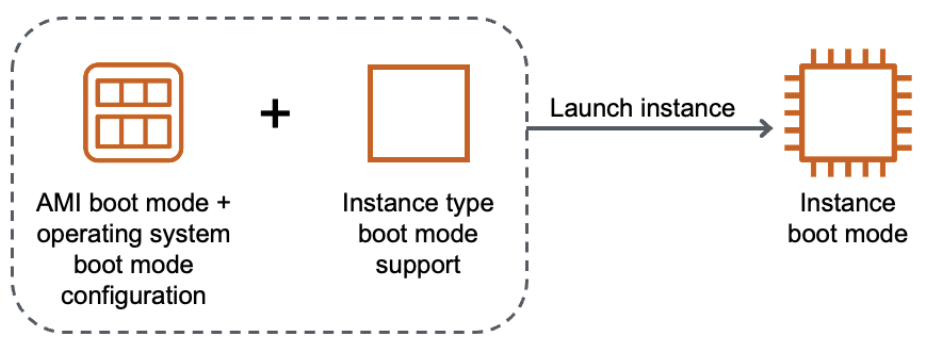您可以在 UEFI 或传统 BIOS 启动模式下启动实例。
在 Local Zones、Wavelength Zones 中,或者使用 AWS Outposts 的情况下,不支持 UEFI 启动。
启动实例时请注意以下事项:
实例的启动模式由 AMI 的配置、其中包含的操作系统和实例类型决定,如下图所示:

下表显示,实例的启动模式(由生成的实例启动模式列表示)由 AMI 的启动模式参数(第 1 列)、AMI 中包含的操作系统的启动模式配置(第 2 列)和实例类型的启动模式支持(第 3 列)共同决定。
| AMI 启动模式参数 | 操作系统启动模式配置 | 实例类型启动模式支持 | 生成的实例启动模式 |
|---|---|---|---|
| UEFI | UEFI | UEFI | UEFI |
| 传统 BIOS | 传统 BIOS | 传统 BIOS | 传统 BIOS |
| UEFI Preferred | UEFI | UEFI | UEFI |
| UEFI Preferred | UEFI | UEFI 和传统 BIOS | UEFI |
| UEFI Preferred | 传统 BIOS | 传统 BIOS | 传统 BIOS |
| UEFI Preferred | 传统 BIOS | UEFI 和传统 BIOS | 传统 BIOS |
| 未指定启动模式 – ARM | UEFI | UEFI | UEFI |
| 未指定启动模式 – x86 | 传统 BIOS | UEFI 和传统 BIOS | 传统 BIOS |
默认启动模式:
Graviton 实例类型:UEFI
Intel 和 AMD 实例类型:传统 BIOS
除了传统 BIOS 外,支持 UEFI 的 Intel 和 AMD 实例类型:
所有基于 AWS Nitro System 构建的实例,下列实例除外:裸机实例、DL1、G4ad、P4、u-3tb1、u-6tb1、u-9tb1、u-12tb1、u-18tb1、u-24tb1 和 VT1
可用的实例类型因 AWS 区域 而异。要查看某个区域中支持 UEFI 的可用实例类型,请使用带 --region 参数的 describe-instance-types 命令。如果省略 --region 参数,则会在请求中使用默认区域。包括 --filters 参数以将结果范围限定为支持 UEFI 的实例类型,并包括 --query 参数以将输出范围限定为 InstanceType 的值。
使用适用于您操作系统的命令。
$ aws ec2 describe-instance-types --filters Name=supported-boot-mode,Values=uefi --query "InstanceTypes[*].[InstanceType]" --output text | sort a1.2xlarge a1.4xlarge a1.large a1.medium a1.metal a1.xlarge c5.12xlarge ...
Windows
$ aws ec2 describe-instance-types --filters Name=supported-boot-mode,Values=uefi Name=processor-info.supported-architecture,Values=x86_64 --query "InstanceTypes[*].[InstanceType]" --output text | sortc5.12xlarge
c5.18xlarge
c5.24xlarge
c5.2xlarge
c5.4xlarge
c5.9xlarge
c5.large
...
目前,裸机实例不支持 UEFI 安全启动和非易失性变量。使用上述示例所述的 describe-instance-types 命令,但通过包含 Name=bare-metal,Values=false 筛选条件筛选出裸机实例。有关 UEFI 安全启动的信息,请参阅 UEFI 安全启动。
使用适用于您操作系统的命令。
$ aws ec2 describe-instance-types --filters Name=supported-boot-mode,Values=uefi Name=bare-metal,Values=false --query "InstanceTypes[*].[InstanceType]" --output text | sorta1.2xlarge a1.4xlarge a1.large a1.medium ...
Windows
$ aws ec2 describe-instance-types --filters Name=supported-boot-mode,Values=uefi Name=bare-metal,Values=false Name=processor-info.supported-architecture,Values=x86_64 --query "InstanceTypes[*].[InstanceType]" --output text | sortc5.12xlarge
c5.18xlarge
c5.24xlarge
c5.2xlarge
...
要在 UEFI 启动模式下启动实例,必须选择支持 UEFI 的实例类型,然后为 UEFI 配置 AMI 和操作系统,如下所示:
实例类型
启动实例时,必须选择支持 UEFI 的实例类型。有关更多信息,请参阅 确定实例类型支持的启动模式。
AMI
启动实例时,必须选择为 UEFI 配置的 AMI。AMI 必须按如下方式进行配置:
Linux – 以下 Linux AMI 支持 UEFI:
至于其他 Linux AMI,则必须配置 AMI,通过 VM Import/Export 导入 AMI,或通过 CloudEndure
Windows:以下 Windows AMI 支持 UEFI:
TPM-Windows_Server-2022-English-Full-Base
TPM-Windows_Server-2022-English-Core-Base
TPM-Windows_Server-2019-English-Full-Base
TPM-Windows_Server-2019-English-Core-Base
TPM-Windows_Server-2016-English-Full-Base
TPM-Windows_Server-2016-English-Core-Base
Amazon Linux 2023
Amazon Linux 2(仅适用于 Graviton 实例类型)
操作系统 – AMI 中包含的操作系统必须配置为使用 UEFI;否则,实例启动将失败。有关更多信息,请参阅 确定操作系统的启动模式。
AMI 启动模式参数 – AMI 的启动模式参数必须设置为 uefi 或 uefi-preferred。有关更多信息,请参阅 确定 AMI 的启动模式参数。





